Sharfunnisa, 70, a resident of Varthur in south-eastern Bengaluru, has been struggling to arrange for water for her family’s daily needs. As the prices of water tankers have shot up exponentially over the last one month, a few houses in the neighbourhood, all one-room tenements, have now decided to order one water tanker and share the costs.
“A 4,000-litre tanker was about ₹500-₹600 a month ago; now it costs ₹1,000. Over and above this, we need to buy drinking water cans. Our water expenses grew to over ₹4,000 in February. And this is just the beginning of summer. The water tanker operators have been warning us that the costs may double soon,” says Samina Taj, 35, another resident of the area.
Also read | BBMP directs drilling borewells in 58 areas with drinking water crisis
Households in Bengaluru, dependent on water supply from the Cauvery river or water tankers, are preparing for the situation to worsen as the city stares at a severe summer.
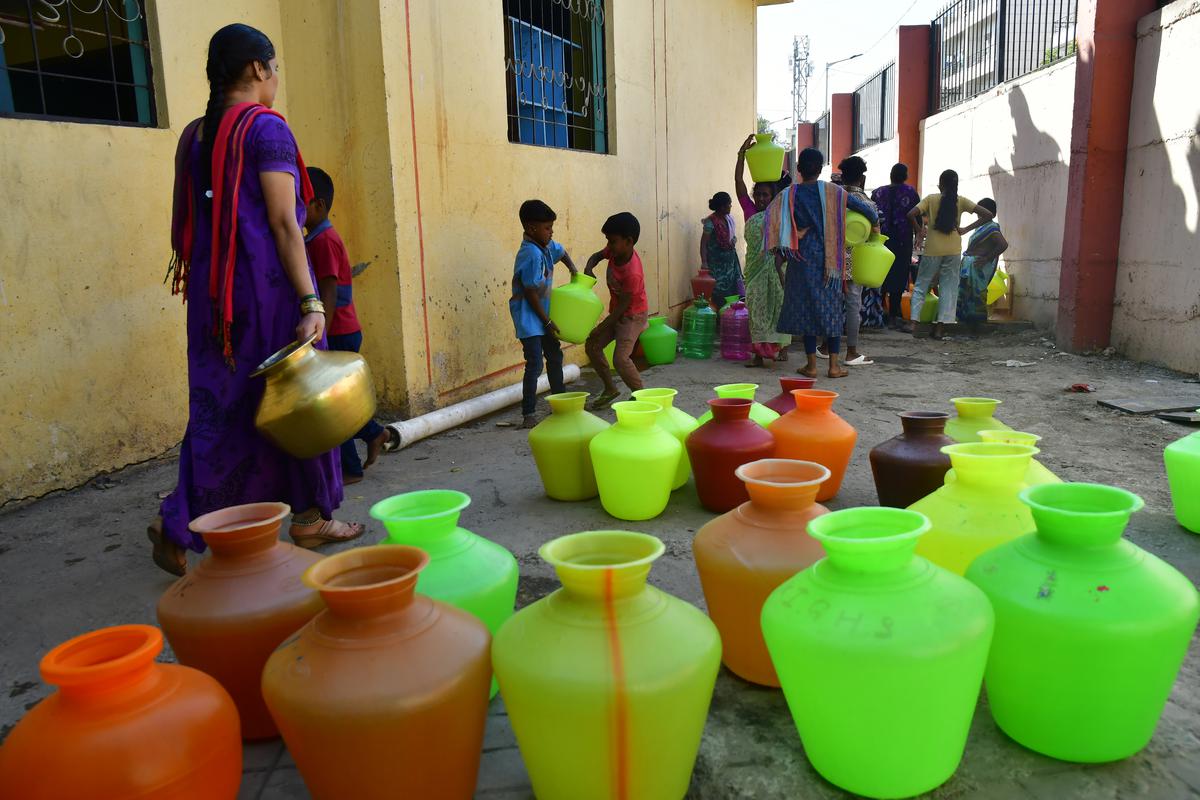
Women and children collect potable drinking water from a public tap at Nayandahalli off Mysuru road, in Bengaluru. The water is supplied by the Bangalore Water Supply and Sewerage Board.
| Photo Credit:
K. Murali Kumar
Ganga P., a senior citizen who lives in an independent house in east Bengaluru, says she washes clothes less often, preferring instead to hang them out to dry in the hot sun if they have been worn only for a few hours. She also hand-washes clothes as far as possible, to save water. “I have stopped using water to clean the veranda of my house. I mop the floor daily to save water so I don’t have to buy a tanker,” she says.
Also read | BBMP makes registration of water tankers mandatory in Bengaluru
Whitefield and Varthur, which house the Information Technology corridor in eastern Bengaluru, are some of the worst-affected areas by the drinking water crisis. The Bruhat Bengaluru Mahanagara Palike (BBMP), the city’s civic body, has directed officials to dig borewells in 58 areas which are reeling under the crisis. Of them, 16 are in Mahadevapura, 25 in R.R. Nagar, five in Bommanahalli, and three each in the Yelahanka and Dasarahalli zones.
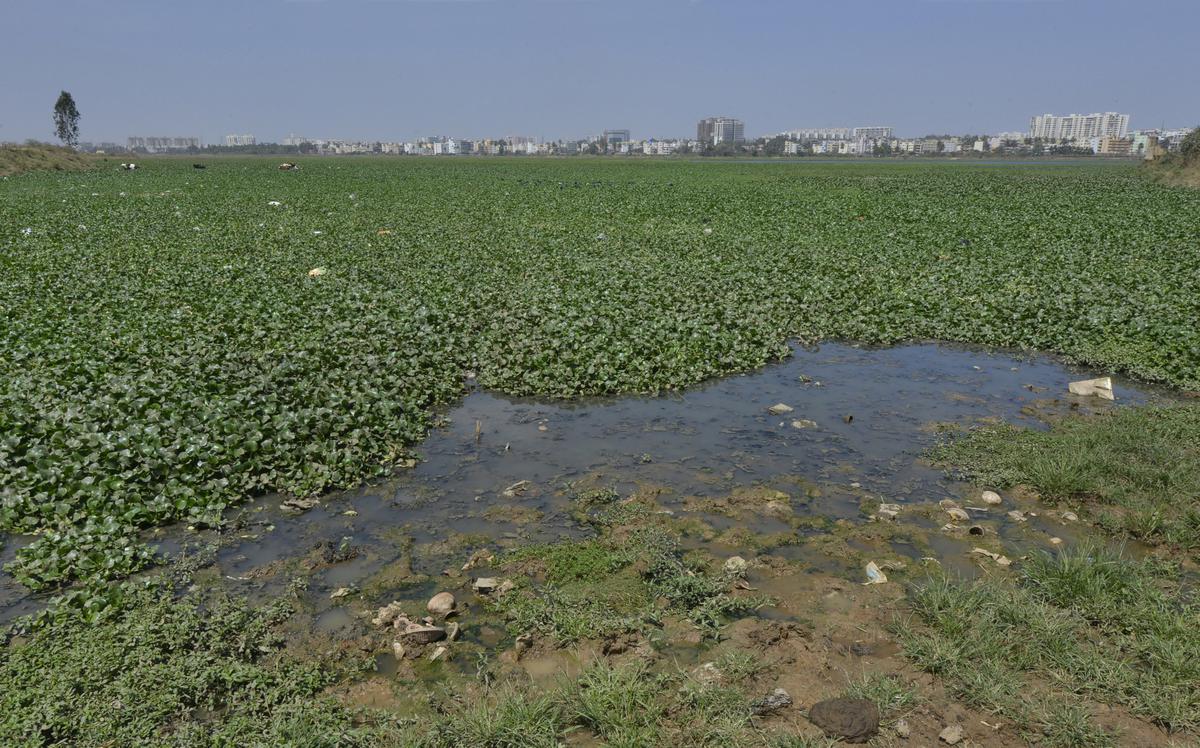
Varthur lake, one of the biggest in Bengaluru, was used for irrigation purposes. Now it is polluted.
| Photo Credit:
K. Bhagya Prakash
No one has been spared; water has become a rare commodity even for those who live in posh apartments and can afford to buy it easily. Unlike the older parts of the city where, despite the drought, the State government has prioritised drinking water needs over irrigation and assured supply till the next monsoon, these areas are not yet serviced by piped water supply from the Cauvery river. On account of unplanned growth over the last two decades, these regions have been stretched beyond their capacity. Basic infrastructure such as drinking water and underground drainage are absent in these areas, so they rely on borewells and water tankers.
Karnataka saw consecutive years of surplus rain, but the monsoon failed in 2023. The underground water table levels are depleted, aggravating the water crisis. Borewells are the source of water ATMs, or easy access points to vend safe water, of the BBMP. As they have also dried up, the civic body has put up posts at several water ATMs stating that one person can take only one pot of water a day.
Down to a trickle
In these areas, water is the most commercialised and politicised commodity. Even before these neighbourhoods joined the city’s civic limits in 2007, the local panchayats had dug borewells and laid pipelines to supply water; these are now overseen by the BBMP. But many of these borewells have gone dry or the force of water is down to a trickle, disrupting service in many areas.
“The water man (who is in charge of of releasing water in specific areas) acts like a king. We need to go and beg at his house for water. We pay the water board. But he doesn’t give us water unless we pay him,” says Radha S., 45. She adds that the local MLA and former councillor also target blocks that have not voted for them. In such a scenario, water tankers have become ubiquitous.

The residents of Bangarappanagar fetch drinking water supplied by BWSSB in the Rajarajeshwari Nagar zone, in Bengaluru.
| Photo Credit:
K. Murali Kumar
In the absence of any regulatory mechanism, the prices of water tankers have been erratic. Tankers usually come in three capacities — 4,000 litres, 6,000 litres, and 12,000 litres. The prices of these have shot up to ₹1,000, ₹1,500 and over ₹2,000, respectively. For the first time, the price has crossed the ₹2,000-mark in the city.
Also read | Mekedatu imperative for Bengaluru’s water needs: Deve Gowda
The cost of water tankers has shot up to such an extent that even residents of apartments have been complaining that sourcing water is becoming increasingly hard and their monthly maintenance costs are going up. Many of them have started rationing water to flats. They use recycled water for gardening and have stopped filling up their swimming pools. Recently, an internal note by an apartment on Kanakapura Road, south of Bengaluru, went viral. It notified its members that water would be supplied only after 11.30 am after the morning peak hours to conserve water.
Prasad, a resident of an apartment community in Whitefield, says their borewells have completely dried up, forcing them to rely on water tankers. “A few days ago, the tankers that used to supply water for us stopped taking our calls. They suggested that we contact other operators. When we did that, those operators quoted far higher prices. We had no option but to buy water at the new rates,” he says.
Price cap for water tankers
Deputy Chief Minister D.K. Shivakumar recently said that 25% of the city’s water needs are met by water tankers. The civic administration has made registration of all water tankers in the city, an estimated 3,500, mandatory by March 7. It has announced that it will cap the tanker prices after a meeting with stakeholders in the next few days.
But water tanker dealers dispute the ‘tanker mafia’ tag, used by desperate citizens and even political parties. They argue that as borewells have gone dry, water tankers are now going at least 40 kilometres away from the city to fetch water.
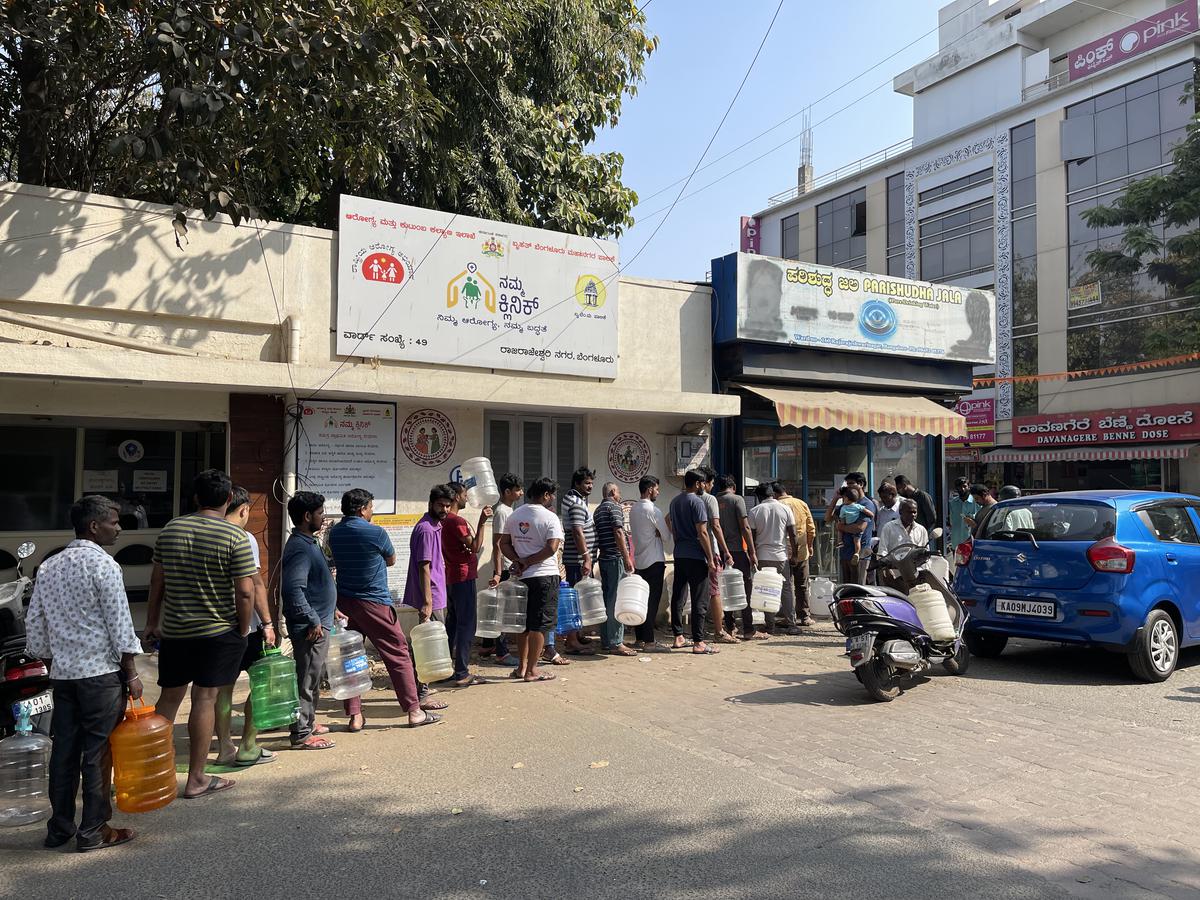
A long queue to fetch drinking at Rajarajeshwari Nagar, in Bengaluru.
| Photo Credit:
K. Murali Kumar
Praveen Reddy, a water tanker businessman in Marathahalli, an eastern suburb, says on average, a water tanker’s journey to the source and to the customer has gone up to 50 km from less than 30 km a year ago. “If we were taking half an hour to fill a 12,000 litre tanker from a borewell earlier, now it takes over three hours as the water has depleted. The prices that landowners are charging for digging borewells have also shot up. We are working under severe pressure and are unable to meet the rising demand,” he says. He narrates the story of how the residents of an apartment recently waylaid a tanker demanding that it unload the water to them at any cost.
Jagadish Reddy, a social activist from Varthur, says a decade ago, their village had been the site of commercial extraction of water. Varthur had been supplying water to the entire IT corridor and beyond, including areas 15-20 km away.
“We did not realise how it would affect the village resources then. Today, the underground water table in the village has depleted extensively and water tankers have to go nearly 20 km beyond Varthur, up to Chikka Tirupati, to fetch water now,” he says.
Reddy adds that due to rapid development of the region, the residents had no choice but to allow commercial extraction of water to cater to the burgeoning population. “Some villages will have to pay the price. Now a few surrounding villages are not allowing commercial extraction, forcing tankers to move farther away,” he says.
The civic administration has now stepped in to provide some solace to the poor. Bengaluru’s Chief Civic Commissioner Tushar Giri Nath has announced that invoking the Disaster Management Act, 2005, the administration will commandeer 200 water tankers over the next few days to supply free water to 58 dry patches identified by the administration.
Of the 10,955 borewells drilled by the civic administration in the city, 1,214 have completely dried up. In 3,700 others, the water levels have dropped. The civic body has now released ₹131 crore to redrill some of these borewells and dig new ones in the outer zones. But as the aquifer levels have depleted, this may be too little too late.
The changing face of the city
While the IT capital reels under a water crisis not seen in recent times, experts say this was only waiting to happen. Rashmi Kulranjan and Shashank Palur, hydrologists at WELL Labs under the Urban Water Programme, point out that though there are reports of water shortages in other cities due to the variability of rainfall from the southwest monsoon last year, cities such as Delhi and Kolkata are not as vulnerable due to their proximity to major rivers. “Bengaluru is not situated near a major river or coast. So, it relies on an expensive and unreliable source of water that is located 90 km away and 350 metres below the city’s elevation. Half the city’s supply is still provided by groundwater. And this fluctuates significantly according to the season,” says Shashank.
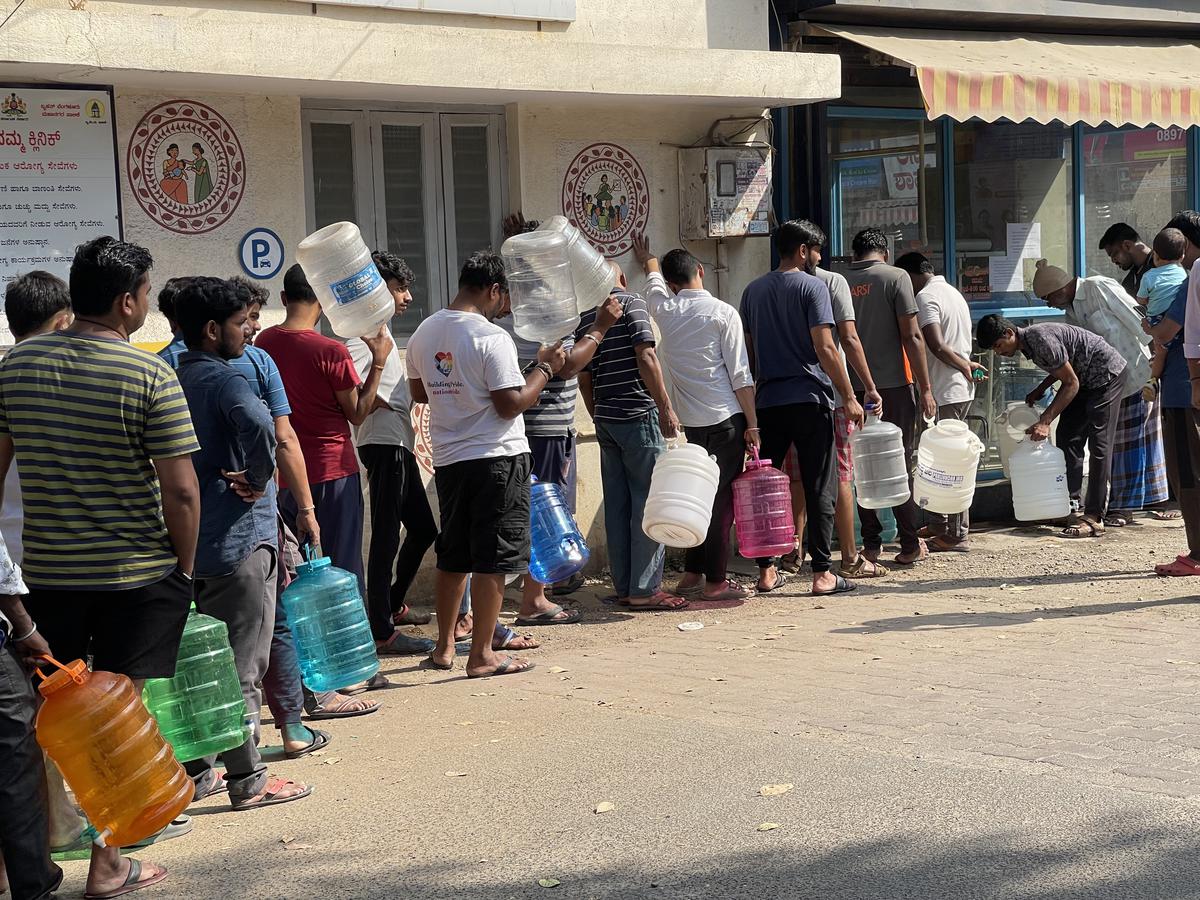
People stand in front of a water ATM at Rajarajeshwari Nagar, Bengaluru.
| Photo Credit:
K. Murali Kumar
Bengaluru was not always dependent on networks of pipelines or borewells pumping water from afar or from below the ground, says Rashmi. “Most of the city’s water bodies were originally ‘tanks’, rainwater harvesting structures constructed mainly to serve irrigation and livestock purposes. The undulating terrain of the city allowed for man-made cascading lake systems to be built; these played a critical role in managing the availability and surplus of water. Despite centuries of effort that went into building the region’s water resilience, lakes eventually began to lose their importance with the introduction of piped water supply,” she says.
Shashank says with rapid urbanisation, lakes have been directly encroached on or are drying out. “This has not only resulted in a more parched city, but also aggravated the risk of flooding. The lakes and storm water drains have also become a dumping ground for treated and untreated sewage from the buildings around them. This affects the possibility of using them to capture rainwater or storm water,” he says.
The loss of the city’s blue-green infrastructure — water bodies and parks and green spaces that allow water to percolate — has resulted in a significant underutilisation of rainwater harvesting and capture methods, he adds. The highly polluted Vrushabhavathy, the only river that originates in Bengaluru, and Bellandur lake, one of the largest in the city, are prime examples.
Ironically, as the two of them point out, Bengaluru is situated between two river basins. To its west are Vrushabhavathy and Arkavathy, tributaries of the Cauvery, and on its east is the Ponniyar or Dakshin Pinakini. But Vrushabhavathy, the only river originating in the city, has become polluted due to sewage and effluent discharge.
T.V. Ramachandra from the Centre for Ecological Sciences, Indian Institute of Science, says Bengaluru receives annual rainfall of 700-850 millimetres, which amounts to 15 TMC (one thousand million cubic feet) of rainwater. The city requires 18 TMC of water, which means that 70% of the water required comes from rainwater.
“We need to make rainwater harvesting mandatory, rejuvenate lakes on priority so that we can store rainwater, ensure complete treatment of domestic sewage, apply the ‘polluter pays’ principle to industries discharging untreated industrial effluents as per the Water Act of 1974, create mini forests of 1-2 hectares with native species in each ward, and re-establish inter-connectivity among lakes by evicting all encroachments of storm water drains,” he says.
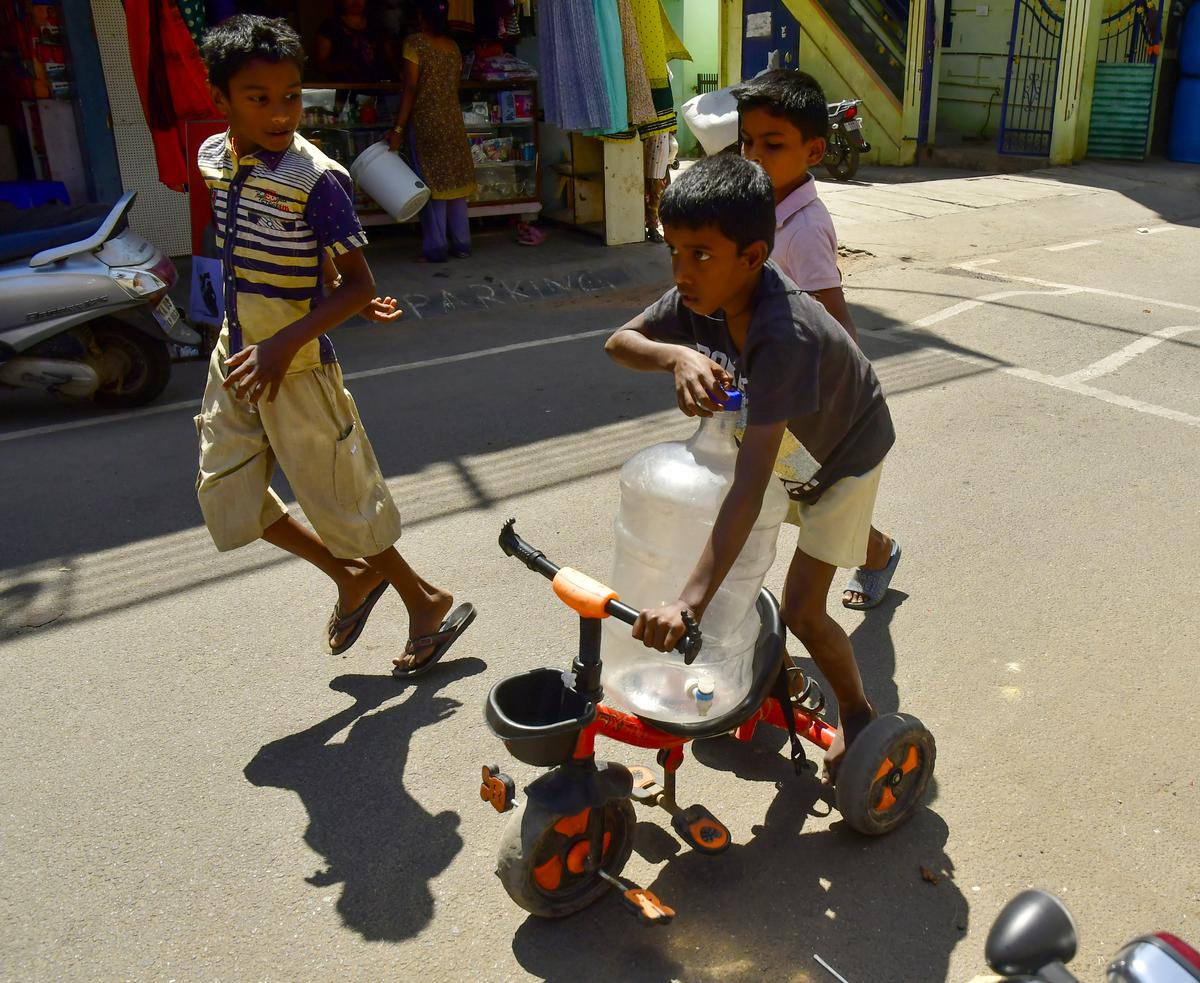
Children carry water cans to fetching drink water in Bangarappanagar, Bengaluru
| Photo Credit:
K. Murali Kumar
Rashmi says the Cauvery currently supplies 1,460 million litres per day (MLD) of water across four stages. Water supply from the Cauvery is done in various stages, the fifth being the newest. When the fifth stage is completed, an additional 775 MLD will be added to the supply.
“However, water levels in the river fluctuate seasonally. Currently, the reservoir capacity in the Cauvery basin has decreased to 40%, even before the onset of summer. The Bengaluru water board spends ₹3 crore per day as electricity charges to pump the water into the city. Additionally, the feasibility report for the construction of the Mekadatu reservoir, aimed at augmenting water supply to the city, reveals that the project entails the submergence of 4,996 hectares of wildlife, forest, and revenue land,” she says.
Instead of expending huge resources to source water from afar, other options must be considered, including those within the city, Shashank says. “The city produces 1,941 million litres of wastewater every day. This is likely to go up as the population increases. Treating and reusing it could significantly cut down on freshwater demand and reduce the city’s vulnerability to water scarcity. Bengaluru, notably, is unique for its number of on-site sewage treatment plants at apartment buildings and commercial establishments, but there is a need for better standards and mechanisms to treat and reuse this water more effectively. Bengaluru could also benefit from adopting strategies employed by other water-scarce cities like Chennai, which have proactively implemented indirect potable reuse by harnessing surface water bodies,” he says.
Replenishing groundwater is another crucial step to improve the city’s water security, says Rashmi, adding that to address the seasonal fluctuations in groundwater levels, utilising open spaces such as fallow land and green areas to recharge shallow aquifers with rainwater during the monsoon season could prove beneficial.
Finally, environment literacy should be enhanced, Ramachandra adds. “Conservation, waste minimisation, and nature-based solutions should be part of our daily routine,” he says.